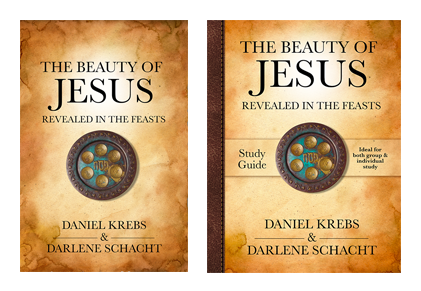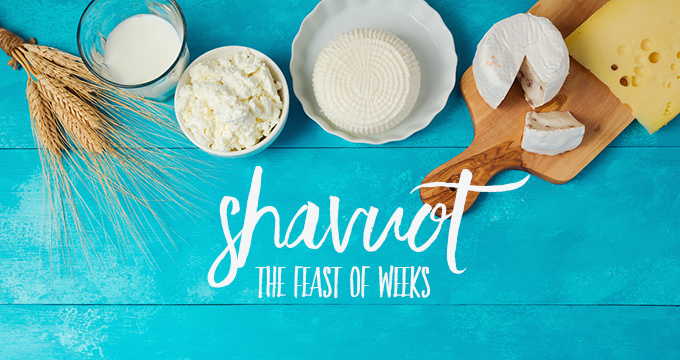The Beauty of Jesus Revealed in the Feasts
You can find both the book and the study guide on Amazon:
Click here for the book, and here for the study guide
Chapter 4 – The Feast of Weeks
What is the Greek word for Shavuot? And why is it known as “The Festival of Weeks?”
The Greek word is Pentecost. This feast comes 7 weeks after the Festival of First Fruits and is therefore known as the Festival of Weeks.
What is the difference between the “Day of Firstfruits” and the “Feast of Firstfruits?” And when is each of them celebrated?
Shavuot is sometimes referred to as the “Day of First Fruits,” and yet there was a “Feast of First Fruits” 50 days prior to it. At that time, they harvested the barley that they had planted in winter, now it was time to harvest the wheat that was planted in spring.
What is the tradition of “counting the omer?”
During those 50 days of waiting many families join in on a tradition known as “counting the omer,” which is, in fact, counting the days leading up to Shavuot. It’s referred to as counting the omer because they are to begin this count on the day after the omer of barley is offered up to the Lord at the Feast of First Fruits.
What are the parallels between Acts Chapter 2 and Exodus Chapter 19?
Both took place 50 days after The Feast of First Fruits.
In Exodus God proclaimed that they would be a Holy Nation if they continued to obey Him, and in Acts He established His church.
Both had fire.
Both had a loud noise.
In Exodus the law was written on stone. In Acts the law was written on their hearts.
How were betrothal ceremonies different from our modern engagements?
Unlike modern engagements, betrothals were the fullness of a commitment to marriage. An official document was drawn up through which the groom offered monetary security that served to protect the woman in the case of divorce and provide for her future.
This security is sometimes referred to as a bride price. We see this in the Old Testament as families negotiate the terms of engagement. For example, Jacob worked 14 years for his uncle in order to marry Leah and Rachel. David’s bride price was an odd one as he sought to marry Michal the king’s daughter. Assuming he would fail, Saul required that David give him 100 foreskins of the Philistines. David doubled that, killing 200 Philistines and delivering their foreskins to the king.
A betrothal was binding, and in fact, the only way to break one’s betrothal was to get a divorce.
What were the Jews commanded to bring to the festival?
In Deuteronomy 26, we see that the Lord commanded them to bring a basket of their first fruits. The farmers would designate the first fruit was by tying a reed to it the moment it came to fruition. This allowed the farmer to recognize the first fruits upon harvest, and to designate them for the Lord.
In Leviticus 23, we also see that the Lord commanded them to “bring two loaves made of two-tenths of an ephah of the finest flour, baked with yeast, as a wave offering of firstfruits to the Lord.” (Leviticus 23:17)
They were also to “present with this bread seven male lambs, each a year old and without defect, one young bull and two rams. They will be a burnt offering to the Lord, together with their grain offerings and drink offerings—a food offering, an aroma pleasing to the Lord. Then sacrifice one male goat for a sin offering[c] and two lambs, each a year old, for a fellowship offering.” (Leviticus 23:18-19)
Why was the bread leavened? And what did the two loaves symbolize?
It was leavened because it symbolized man—both Jew and Gentile coming together in one offering before the Lord.
In the story of Ruth, what did the two daughters each symbolize? And why is this story read aloud during the celebration of this feast?
This story illustrates the difference between a true follower of God (Ruth) and one who simply vows to follow God (Orpah). Both Ruth and Orpah set out on the road with Naomi, and both of them vowed to follow her home, but only one of them stayed true to her vow.
Who was the unnamed man in the story of Ruth? Who or what did his character symbolize?
He symbolized the law, which couldn’t do what Jesus could. The nearest kinsman would have to marry Ruth in order to purchase the property which mean that he would be financially responsible for both Ruth and Naomi.
At this, the guardian-redeemer said, “Then I cannot redeem it because I might endanger my own estate. You redeem it yourself. I cannot do it.” (Ruth 4:6)
We see a parallel here as the law was powerless to do what only Christ could.
For what the law was powerless to do because it was weakened by the flesh, God did by sending his own Son in the likeness of sinful flesh to be a sin offering. And so he condemned sin in the flesh. (Romans 8:3)
Who did the character of Boaz symbolize?
Jesus Christ, our Kinsman Redeemer.


